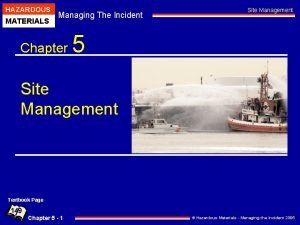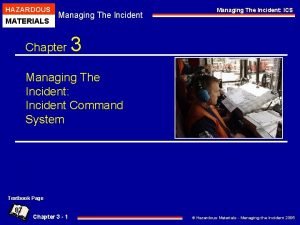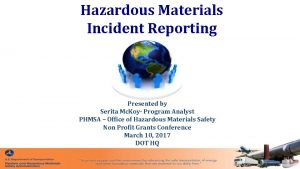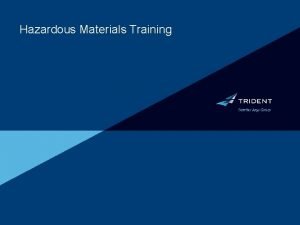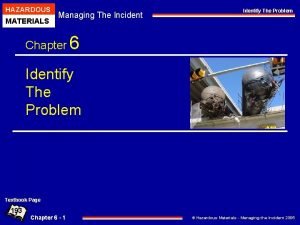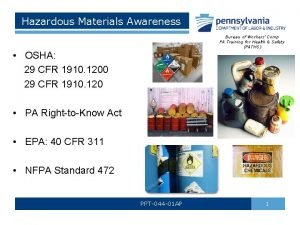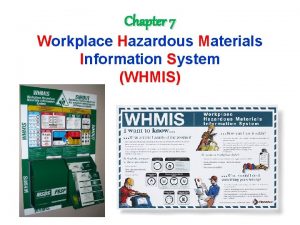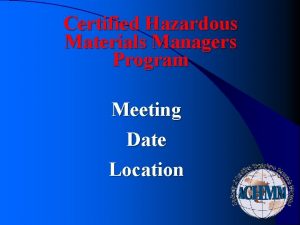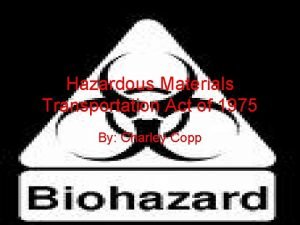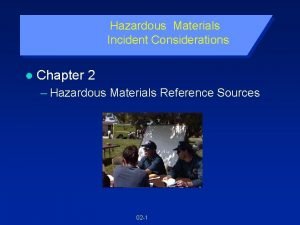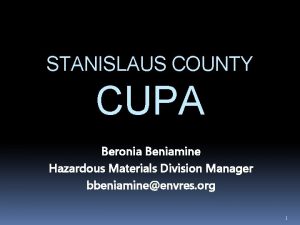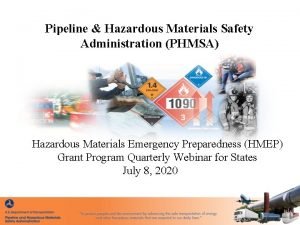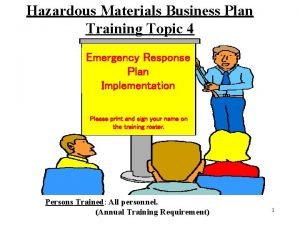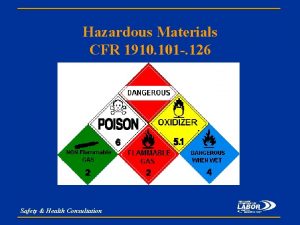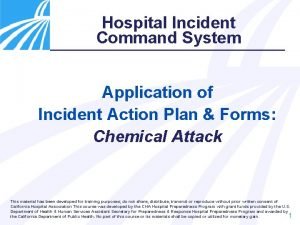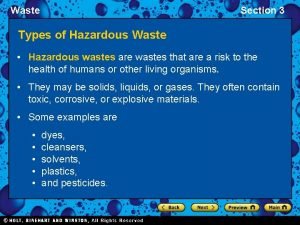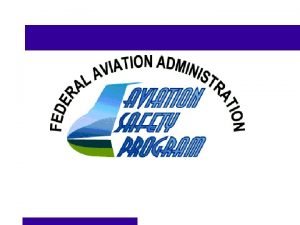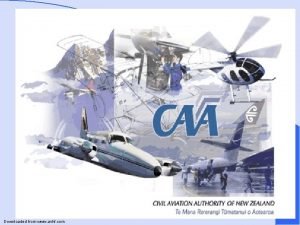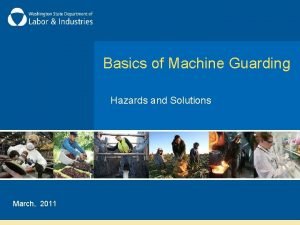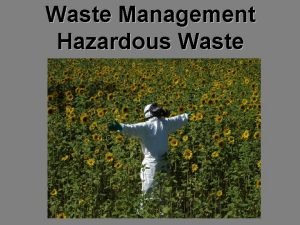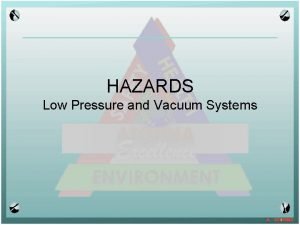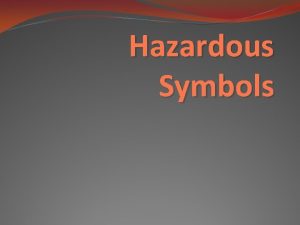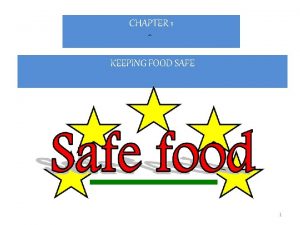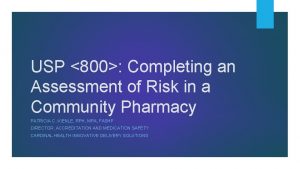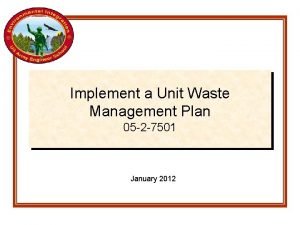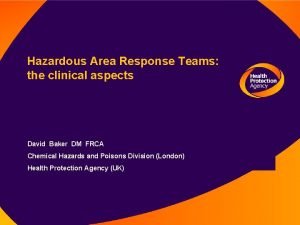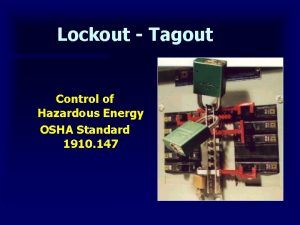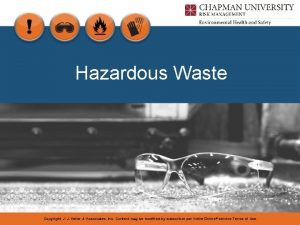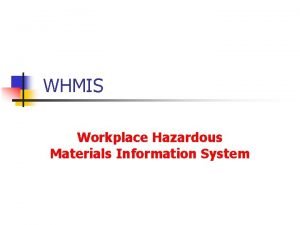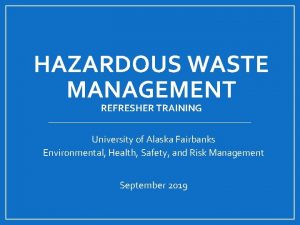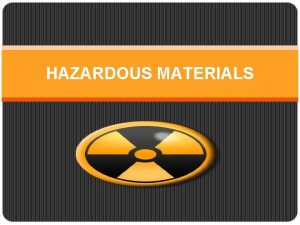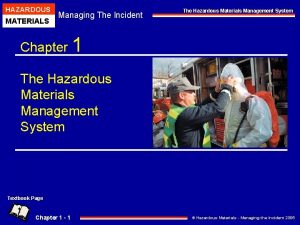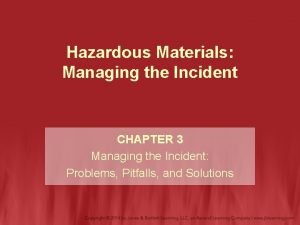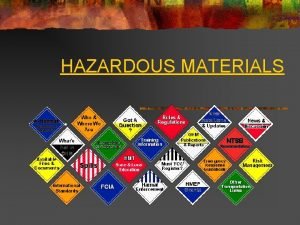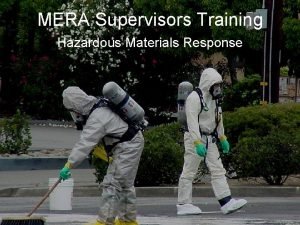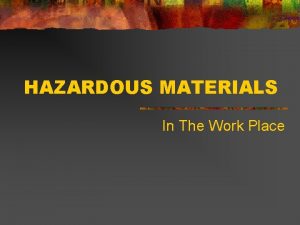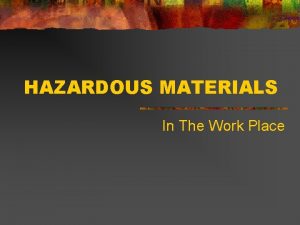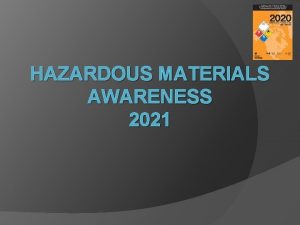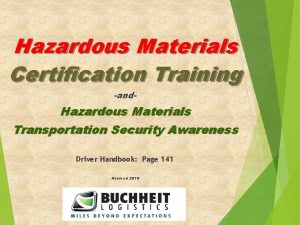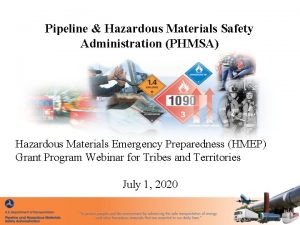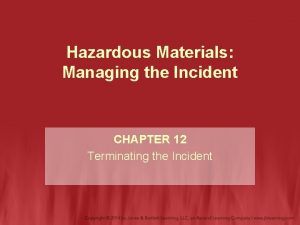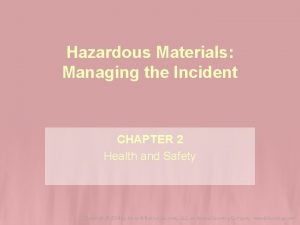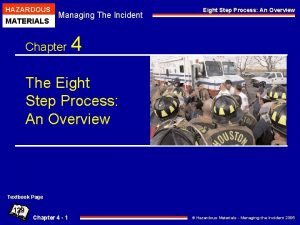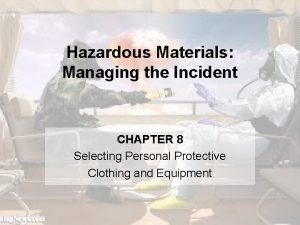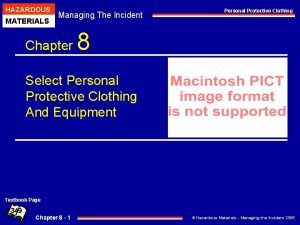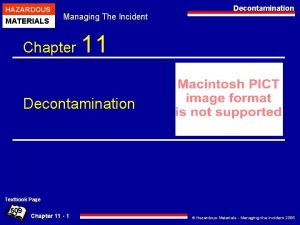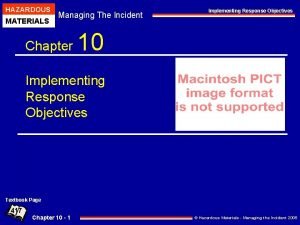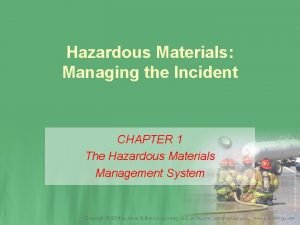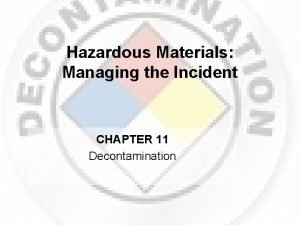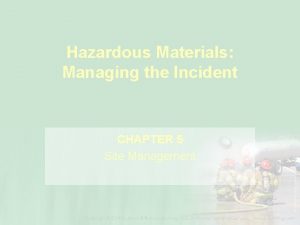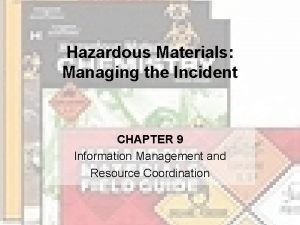HAZARDOUS MATERIALS Managing The Incident Chapter Managing The









































































- Slides: 73

HAZARDOUS MATERIALS Managing The Incident Chapter Managing The Incident: ICS 3 Managing The Incident: Incident Command System Textbook Page 87 Chapter 3 - 1 © Hazardous Materials - Managing the Incident 2005

HAZARDOUS MATERIALS Managing The Incident: ICS Objectives • List The Categories Of Players And Participants At A Hazardous Materials Incident. • Identify The Key Organizational Elements Of The Incident Command System. Describe The Concept Of Unified Command, And Its Application And Use At A Hazardous Materials Incident. Identify The Key Elements Of The Incident Command System Necessary To Coordinate Response Activities At A Hazardous Materials Incident. • • Chapter 3 - 2 © Hazardous Materials - Managing the Incident 2005

HAZARDOUS MATERIALS Managing The Incident: ICS Objectives • Identify The Duties And Responsibilities Of The Following Hazmat Group Functions Within The Incident Command System: [NFPA 472 - 6. 4. 1. 2] • • Backup Decontamination Entry Hazmat Group Management Hazmat Group Safety Information/Research Reconnaissance Resources Chapter 3 - 3 © Hazardous Materials - Managing the Incident 2005

HAZARDOUS MATERIALS Managing The Incident: ICS Introduction • Direct, Effective Command And Control Operations Are Essential At Every Type Of Incident. • This Chapter Will Review The Fundamental Concepts Of Incident Management And Its Application At A Hazmat Incident. • Primary Topics Will Include: • The Various Players Who Characteristically Appear At A Hazmat Incident • The Elements Of The Incident Command System (ICS) • The Functions And Responsibilities Of The Hazmat Group • “Street Smart” Tips Chapter 3 - 4 © Hazardous Materials - Managing the Incident 2005

HAZARDOUS MATERIALS Managing The Incident: ICS Managing The Incident: The Players • A Hazmat Incident Often Attracts An Interesting Collection Of Participants. • The Key To Success Is To Have A Coordinated Incident Command Structure Where All Of The Players Integrate Their Resources To Make The Problem Go Away In A Safe And Effective Manner. Chapter 3 - 5 © Hazardous Materials - Managing the Incident 2005

HAZARDOUS MATERIALS Managing The Incident: ICS Managing The Incident: The Players • The Basic ICS Organization That Must Be Created To Bridge These Potential Gaps And Problems Includes The Following: • The Incident Commander (Command Or IC) • Unified Commanders (UC) • ICS General Staff • ICS Command Staff Chapter 3 - 6 © Hazardous Materials - Managing the Incident 2005

HAZARDOUS MATERIALS Managing The Incident: ICS The Players • Fire/Rescue/EMS Companies • Police Officers And Law Enforcement Personnel • Emergency Response Team (ERT) • Hazardous Materials Response Teams (HMRT). • Special Operations Teams • Communications Personnel • Responsible Party • Facility Managers • Support Personnel Chapter 3 - 7 © Hazardous Materials - Managing the Incident 2005

HAZARDOUS MATERIALS Managing The Incident: ICS The Players • Technical Information Specialist • Environmental Clean-up Contractors • Government Officials • News Media • Investigators • Victims • Spectators • The Bad Guy • The Hazardous Material Chapter 3 - 8 © Hazardous Materials - Managing the Incident 2005

HAZARDOUS MATERIALS Managing The Incident: ICS • The OSHA 1910. 120(q) Is A Requirement That Both Public Safety And Industrial Emergency Response Organizations Use “Nationally Recognized Incident Command System For Emergencies Involving Hazardous Materials. ” • Experience Has Shown That The Normal, Day-today Business Organization Is Not Well-suited To Meeting The Broad Demands Created By “Working” Hazmat Incidents. 92 Chapter 3 - 9 © Hazardous Materials - Managing the Incident 2005

HAZARDOUS MATERIALS Managing The Incident: ICS • National Incident Management System (NIMS) Is A “Baseline” Incident Management Organization That Is Utilized By Federal, State, And Local Governments, As Well As Many Private Sector Organizations Throughout North America. • The Incident Command System Is An Organized System Of Roles, Responsibilities, And Procedures For The Command And Control Of Emergency Operations. Chapter 3 - 10 © Hazardous Materials - Managing the Incident 2005

HAZARDOUS MATERIALS Managing The Incident: ICS Incident Management Vs. Crisis Management • Crisis Management Is An Integral Element Of Most Corporate And Industrial Organizations. • There Is A Direct Relationship Between Incident Management And Crisis Management • An Incident Can Be Defined As An Occurrence Or Event, Either Natural Or Man-made, Which Requires Action By Emergency Response Personnel To Prevent Or Minimize Loss Of Life Or Damage To Property And/Or Natural Resources. • A Crisis Is An Unplanned Event That Can Exceed The Level Of Available Resources, And Has The Potential To Significantly Impact An Organization’s Operability, Credibility And Reputation, Or Pose A Significant Environmental, Economic, Or Legal Liability. Chapter 3 - 11 © Hazardous Materials - Managing the Incident 2005

HAZARDOUS MATERIALS Managing The Incident: ICS Lessons Learned • A Variety Of Different “Players” Will Respond To A “Working” Hazmat Incident. • What Occurs During The Planning And Preparedness Phase Will Establish The Framework For How The Emergency Response Effort Will Operate. • There Is No Single Agency That Can Effectively Manage A Major Emergency Alone. • Many Special Operations Teams, Including HMRT, Tend To Be “People-dependent” Programs. Chapter 3 - 12 © Hazardous Materials - Managing the Incident 2005

HAZARDOUS MATERIALS Managing The Incident: ICS Lessons Learned • In Those Cases Where ICS Has Not Resulted In The Operational Improvements Expected, The Problems Are Typically Associated With Planning, Training, And The Organization “Buying Into” The ICS Program, As Compared To The ICS System Itself. • The Management And Control Of Routine, Day-today Incidents Establishes The Framework For How The Larger, More Significant Events Will Be Managed. Chapter 3 - 13 © Hazardous Materials - Managing the Incident 2005

HAZARDOUS MATERIALS Managing The Incident: ICS Elements • Division Of Labor • Lines Of Authority Are Clearly Defined • Unity Of Command • Optimum Span Of Control • Establishment Of Both Line And Staff Functions Chapter 3 - 14 © Hazardous Materials - Managing the Incident 2005

HAZARDOUS MATERIALS Managing The Incident: ICS Common Terminology of ICS • Incident Commander (IC) • Sections • • Operations Section Planning Section Logistics Section Administration / Finance Section • Branch • Division/Group/Sectors • Command Staff Officers • Safety Officer / Liaison Officer / Information Officer Chapter 3 - 15 © Hazardous Materials - Managing the Incident 2005

HAZARDOUS MATERIALS Managing The Incident: ICS Modular Organization • The ICS Organizational Structure Develops In A Modular Fashion Based Upon The Size And Nature Of The Incident. • The System Builds From The Top Down, With Initial Responsibility And Performance Placed Upon The IC. • At The Very Least, An IC Must Be Identified On All Incidents, Regardless Of Their Size. • The Specific ICS Organizational Structure Will Be Based Upon The Management Needs Of The Incident. Chapter 3 - 16 © Hazardous Materials - Managing the Incident 2005

HAZARDOUS MATERIALS Managing The Incident: ICS Managing The Incident Pre-designated Incident Facilities • Emergencies Require A Central Point For Communications And Coordination. • There Can Be Two Central Points • Incident Command Post (ICP) • Emergency Operations Center (EOC) Chapter 3 - 17 ICP EOC © Hazardous Materials - Managing the Incident 2005

HAZARDOUS MATERIALS Managing The Incident: ICS Pre-designated Incident Facilities - ICP • Incident Command Post (ICP) • The “On-scene” Location Where The IC Develops Goals And Objectives, Communicates With Subordinates, And Coordinates Activities Between Various Agencies And Organizations. • An ICP Should Provide Command With The Following: • A Place Safe From The Hazardous Material(s) Or Problem. • A Quiet (Relatively) Place Where You Can Think, Discuss, And Decide. • A Vantage Point From Which To See (When Possible). • Inside Lighting and A Place To Write And Record. • Protection From The Weather and the Media • Staff Space Chapter 3 - 18 © Hazardous Materials - Managing the Incident 2005

HAZARDOUS MATERIALS Managing The Incident: ICS Pre-designated Incident Facilities - ICP • Incident Command Post (ICP) • Minimum Equipment Should Include: • Radio Capability To Communicate With Responders, Mutual Aid Units, And Facility Maintenance/Operations Personnel • Cellular Telephone Capability • Copies Of Appropriate Emergency Response Guidebooks And Other Reference Sources • Technical And Administrative Support, Including The Possible Use Of Laptop Computers, Personal Data Assistants (PDA), And Related Electronic Equipment • ICS Command Vests • Tactical Command Chart • Pair Of Binoculars Chapter 3 - 19 © Hazardous Materials - Managing the Incident 2005

HAZARDOUS MATERIALS Managing The Incident: ICS Managing The Incident Pre-designated Incident Facilities - EOC • Emergency Operations Center (EOC) • Where The ICP Is The Nerve Center Of On-scene Operations And Is Usually Located Near The Scene Of The Emergency. • The EOC Is Located Based Upon Physical Needs And Safety Requirements, The EOC Is Normally Remote From The Emergency Scene. • It Is Important To Understand The Differences And Relationship Between The ICP And The EOC. • The ICP Is Primarily Oriented Towards Tactical Control Issues Pertaining To The “On-scene” Response. • The EOC Deals With Both Strategic And External World Issues, And Coordinates All Logistical And Resource Support For Onscene Operations. Chapter 3 - 20 © Hazardous Materials - Managing the Incident 2005

HAZARDOUS MATERIALS Managing The Incident: ICS Pre-designated Incident Facilities - EOC • An EOC Should Be Equipped With The Following: • Radio, Phone And Fax Communications. • Detailed Copies Of Area And Facility Maps, Site Plot Plans, Emergency Pre-plans, Hazard Analysis Documentation, And Other Related Information. • Copies Of Appropriate Emergency Response Guidebooks And Other Reference Sources. • General Administrative Support, Including Writing Boards, Incident Status And Documentation Boards, Telefax And Copying Machines. Chapter 3 - 21 © Hazardous Materials - Managing the Incident 2005

HAZARDOUS MATERIALS Managing The Incident: ICS Pre-designated Incident Facilities - EOC • An EOC Should Be Equipped With The Following: • Electronic Communication Capabilities, Including The Use Of Computers And Email, The Internet And Intranet, And The Development Of Incident Or Agency-specific Websites. Always Consider The Security Of Your Electronic Communication System. • Television Sets And Am/Fm Radios To Monitor Local And National News Coverage. • Back-up Emergency Power Capability To Support EOC Lighting, Telephone, And Radio Base Stations Chapter 3 - 22 © Hazardous Materials - Managing the Incident 2005

HAZARDOUS MATERIALS Managing The Incident: ICS Pre-Designated Incident Facilities - Staging Area • Staging Area is The Designated Location Where Emergency Response Equipment And Personnel Are Assigned On An Immediately Available Basis Until They Are Needed. • The Staging Area Should Be Clearly Identified Through The Use Of Signs, Color-coded Flags Or Lights, Or Other Suitable Means. • Staging Becomes An Element Within The Operations Section. Chapter 3 - 23 © Hazardous Materials - Managing the Incident 2005

HAZARDOUS MATERIALS Managing The Incident: ICS Integrated Communications • Communications Are Critical To The Safe And Efficient Incident Management. • Communications Are Managed Most Effectively Through The Use Of A Common Communications Center And Network. • Whenever A Situation Is Encountered Which Could Immediately Cause Injuries The Term “Emergency Traffic” Should Precede The Radio Transmission. • Communications Of A Sensitive Nature Should Not Be Given Over Non-secure Cellular Telephones Or Radios Which Can Be Monitored. Chapter 3 - 24 © Hazardous Materials - Managing the Incident 2005

HAZARDOUS MATERIALS Managing The Incident: ICS Managing The Incident Unified Command Structure • A Unified Command Structure Simply Means That The Key Agencies That Have Statutory Or Jurisdictional Responsibility Jointly Contribute To The Process Of: • Determining Overall Incident Priorities And Strategic Goals. • Selection Of Tactics For Achieving Those Incident Priorities And Strategic Goals. • Ensuring Joint Planning For Tactical Activities. • Ensuring That Integrated Tactical Operations Are Conducted. • Maximizing Use Of All Assigned Resources. • Resolving Conflicts Between The Players. 106 Chapter 3 - 25 © Hazardous Materials - Managing the Incident 2005

HAZARDOUS MATERIALS Managing The Incident: ICS Managing The Incident Unified Command Structure … • The Sooner A Unified Command Structure Is Established, The Better. • Unified Command Is Not Management By Committee • There Will Always Be A Lead Agency Or One Agency Which Has 51% Of The Vote As Compared To The Other Players. • When Multiple Agencies Are Involved In The Response, The Selection Of The Operations Section Chief Must Be Made By The Mutual Agreement Of The Unified Command Team. Chapter 3 - 26 © Hazardous Materials - Managing the Incident 2005

HAZARDOUS MATERIALS Managing The Incident: ICS Consolidated Plan Of Action • Every Emergency Incident Needs Some Form Of An Integrated Action Plan (IAP). • The IAP Consists Of Incident Priorities, Strategic Goals, Tactical Objectives, And Resource Requirements. • Emergencies Involving Multiple Organizations Or Jurisdictions Working Within A Unified Command Structure Require Consolidated Action Planning. • As More Organizations Arrive At The Emergency Scene, They Bring With Them Individual Agendas And Objectives. Chapter 3 - 27 © Hazardous Materials - Managing the Incident 2005

HAZARDOUS MATERIALS Managing The Incident: ICS Managing The Incident Consolidated Plan Of Action … • These Agendas And Objectives May Be Driven By: • • • Facility Responsibilities Legally Mandated Requirements Financial Interests Contractual Responsibilities Specific Mission Goals And Charters. • A Consolidated Action Plan Is Used To Ensure That: • Everyone Works Together Toward A Common Emergency Response Goal; That Is, Protecting Life Safety, The Environment, And Property. Chapter 3 - 28 © Hazardous Materials - Managing the Incident 2005

HAZARDOUS MATERIALS Managing The Incident: ICS Managing The Incident Consolidated Plan Of Action … • Individual Response Agendas Are Coordinated So That Personnel And Equipment Are Used Effectively And In A Spirit Of Cooperation And Mutual Respect. • Everyone Works Safely At The Scene Of The Emergency. • The Most Effective Way To Ensure That A Consolidated Plan Of Action Is Implemented Is To Have The Senior Representative Of Each “Major Player” At The Incident Present At The Icp And/Or EOC At All Times. Chapter 3 - 29 © Hazardous Materials - Managing the Incident 2005

HAZARDOUS MATERIALS Managing The Incident: ICS Comprehensive Resource Management • The Incident Commander Must Analyze Overall Incident Resource Requirements And Deploy Available Resources In A Well-coordinated Manner • Logistics And Resource Management Have Been The Achilles Heel Of Many A Response. • Among The Resource Management Lessons Learned As A Result Of Previous Incidents And Exercises Are: • Get It Done Rather Than Argue About Whose Problem It Is. Chapter 3 - 30 © Hazardous Materials - Managing the Incident 2005

HAZARDOUS MATERIALS Managing The Incident: ICS Comprehensive Resource Management. . . • It Is Easier To “Gear Down” Operations Than It Is To Play “Catch Up. ” If You Think You Will Need It, Call For It! • Overreact Until The Emergency Situation Is Fully Assessed And Completely Understood. • React To The Incident Potential, Not The Existing Situation. • Don’t Pay For Stuff You Don’t Need - Downsize Once The Emergency Has Been Stabilized And It Is Safe To Do So. • Accept Help From Others. • Demobilization Is As Important As The Initial Ramp Up And Mobilization. Chapter 3 - 31 © Hazardous Materials - Managing the Incident 2005

HAZARDOUS MATERIALS Managing The Incident: ICS Managing The Incident: Hazmat Group Operations • Depending Upon The Scope And Complexity Of An Incident, Special Operations May Be Managed As Either A Branch Or Group Within The ICS Organization. • The Hazardous Materials Group Is Normally Under The Command Of A Senior Hazmat Officer • Known As The Hazardous Materials Group Supervisor Who, In Turn, Reports To The Operations Section Chief Or The Incident Commander. • The Scope And Nature Of The Problem Will Determine Which Roles Are Staffed. Chapter 3 - 32 © Hazardous Materials - Managing the Incident 2005

HAZARDOUS MATERIALS Managing The Incident: ICS Managing The Incident: Hazmat Group Operations • Primary Functions And Tasks Assigned To The Hazardous Materials Group Include: • • • Safety Function Entry / Back-up Function Decontamination Function Site Access Control Function Information / Research Function • Secondary Functions And Tasks Assigned To The Hazardous Materials Group Include: • Medical Function • Resource Function Chapter 3 - 33 © Hazardous Materials - Managing the Incident 2005

HAZARDOUS MATERIALS Managing The Incident: ICS Hazardous Materials Group Organizational Chart 110 Chapter 3 - 34 © Hazardous Materials - Managing the Incident 2005

HAZARDOUS MATERIALS Managing The Incident: ICS Managing The Incident Hazardous Materials Group Staffing • Hazardous Materials Group Supervisor • The Hazardous Materials Group Supervisor Will Be Trained To The Hazardous Materials Technician Level And Will Normally Be Filled By Either The HMRT Team Leader Or HMRT Officer. • Based Upon The IC's Strategic Goals, The Hazardous Materials Group Supervisor Develops The Tactical Options To Fulfill The Hazmat Portion Of The IAP Chapter 3 - 35 © Hazardous Materials - Managing the Incident 2005

HAZARDOUS MATERIALS Managing The Incident: ICS Managing The Incident Hazardous Materials Group Staffing • Hazardous Materials Group Supervisor • Responsible For Ensuring That The Following Tasks Are Completed, Including: • Hazard Control Zones Are Established And Monitored. • Site Monitoring Is Conducted To Determine The Presence And Concentration Of Contaminants. • Site Safety Plan Is Developed And Implemented. • Establish Tactical Objectives For The Hazardous Materials Entry Team Within The Limits Of The Team's Training And Equipment Limitations. • Ensure That All Hot Zone Operations Are Coordinated With The Operations Section Chief Or Incident Commander To Ensure Tactical Goals Are Being Met. Chapter 3 - 36 © Hazardous Materials - Managing the Incident 2005

HAZARDOUS MATERIALS Managing The Incident: ICS Hazardous Materials Group Staffing • Hazardous Materials Group Safety Officer (Assistant Safety Officer – Hazmat) • The Hazardous Materials Group Safety Officer Reports To The Hazardous Materials Group Supervisor And Is Subordinate To The Incident Safety Officer. • The Hazardous Materials Group Safety Officer Must Have A High Level Of Technical Knowledge To Anticipate A Wide Range Of Safety Hazards. • While It Is Not The Hazardous Materials Group Safety Officer's Job To Make Tactical Decisions Or To Set Goals And Objectives, It Is Their Responsibility To Ensure That Operations Are Implemented In A Safe Manner. Chapter 3 - 37 © Hazardous Materials - Managing the Incident 2005

HAZARDOUS MATERIALS Managing The Incident: ICS Hazardous Materials Group Staffing • Hazardous Materials Group Safety Officer (Assistant Safety Officer – Hazmat) • Specific Functions And Responsibilities Of The Hazardous Materials Group Safety Officer Include: • Advise The Hazardous Materials Group Supervisor Of All Aspects Of Health And Safety, Including Work/Rest Cycles For The Entry Team. • Coordinate Site Safety Activities With The Incident Safety Officer, As Appropriate. • Possess The Authority To Alter, Suspend, Or Terminate Any Activity That May Be Judged To Be Unsafe. • Participate In The Development And Implementation Of The Site Safety Plan. Chapter 3 - 38 © Hazardous Materials - Managing the Incident 2005

HAZARDOUS MATERIALS Managing The Incident: ICS Hazardous Materials Group Staffing • Specific Functions And Responsibilities Of The Hazardous Materials Group Safety Officer Also Include: • Ensure The Protection Of All Hazardous Materials Group Personnel From Physical, Chemical And/Or Environmental Hazards And Exposures. • Identify And Monitor Personnel Operating Within The Hot Zone, Including Documenting And Confirming Both "Stay Times" And "Work Times" For All Entry And DECON Personnel. • Ensure That EMS Personnel And/Or Units Are Provided, And Coordinate With The Hazardous Materials Medical Leader. • Ensure That Health Exposure Logs And Records Are Maintained For All Hazardous Materials Group Personnel, As Necessary. Chapter 3 - 39 © Hazardous Materials - Managing the Incident 2005

HAZARDOUS MATERIALS Managing The Incident: ICS Hazardous Materials Group Staffing • Entry Team / The Entry Leader (Entry Officer) • The Entry Leader Is Responsible For The Following: • Recommend Actions To The Hazardous Materials Group Supervisor To Control The Emergency Situation Within The Hot Zone. • Implement All Offensive And Defensive Actions, As Directed By The Hazardous Materials Group Supervisor, To Control And Mitigate The Actual Or Potential Hazmat Release. • Direct Rescue Operations Within The Hot Zone, As Necessary. • To Coordinate All Entry Operations With The DECON, Hazmat Information, Site Access, And Hazardous Materials Medical Units. Chapter 3 - 40 © Hazardous Materials - Managing the Incident 2005

HAZARDOUS MATERIALS Managing The Incident: ICS Hazardous Materials Group Staffing • Entry Team • Personnel Assigned To The Entry Team Will Include The Entry And Back-up Teams, And Personnel Assigned For Entry Support. • The Back-up Team Is The Safety Team That Will Extract The Entry Team In The Event Of An Emergency. Chapter 3 - 41 © Hazardous Materials - Managing the Incident 2005

HAZARDOUS MATERIALS Managing The Incident: ICS Managing The Incident Hazardous Materials Group Staffing • Decontamination Team / DECON Leader • Are Responsible For The Following: • Determine The Appropriate Level Of Decontamination To Be Provided. • Ensure That Proper DECON Procedures Are Used By The DECON Team, Including DECON Area Set-up, DECON Methods And Procedures, Staffing, And Protective Clothing Requirements. • Coordinate DECON Operations With The Entry Leader, Site Access Control And Other Personnel Within The Hazardous Materials Group. Chapter 3 - 42 © Hazardous Materials - Managing the Incident 2005

HAZARDOUS MATERIALS Managing The Incident: ICS Hazardous Materials Group Staffing • The DECON Team Is Responsible For The Following: • Coordinate The Transfer Of Decontaminated Patients Requiring Medical Treatment And Transportation With The Hazardous Materials Medical Group. • Ensure That The DECON Area Is Established Before Any Entry Personnel Are Allowed To Enter The Hot Zone. • If Rapid Rescue Operations Are Required, Establish An Emergency DECON Capability Until A Formal DECON Area Can Be Set-up. • Monitor The Effectiveness Of DECON Operations. • Control All Personnel Entering And Operating Within The DECON Area. Chapter 3 - 43 © Hazardous Materials - Managing the Incident 2005

HAZARDOUS MATERIALS Managing The Incident: ICS Hazardous Materials Group Staffing • Site Access Control / Site Access Control Leader • Are Responsible For The Following: • Monitor The Control And Movement Of All People And Equipment Through Appropriate Access Routes At The Incident Scene To Ensure That The Spread Of Contaminants Is Controlled. • Based Upon Recommendations From The Entry, DECON, And Info / Research Units, Oversee The Placement Of The Hazard Control Zone Lines. • Establish A Safe Refuge Area And Appoint A Safe Refuge Area Manager. • Ensure That Injured Or Exposed Individuals Are Decontaminated Prior To Departure From The Incident Scene. Chapter 3 - 44 © Hazardous Materials - Managing the Incident 2005

HAZARDOUS MATERIALS Managing The Incident: ICS Hazardous Materials Group Staffing • Hazardous Materials Information / Research Team • The Hazardous Materials Information Team Are Responsible For The Following: • Provide Technical Support To The Hazardous Materials Group. • Research, Gather And Compile Technical Information And Assistance From Both Public And Private Agencies. • Provide And Interpret Environmental Monitoring Information, Including The Analysis Of Hazardous Materials Samples. • Provide Recommendations For The Selection And Use Of Protective Clothing And Equipment. • Project The Potential Environmental Impacts Of The Hazardous Materials Release. Chapter 3 - 45 © Hazardous Materials - Managing the Incident 2005

HAZARDOUS MATERIALS Managing The Incident: ICS Hazardous Materials Group Staffing • Hazardous Materials Medical Unit • The Hazardous Materials Medical Unit And Hazardous Materials Medical Leader Are Responsible For The Following: • Provide Pre-entry And Post-entry Medical Monitoring Of All Entry And Back-up Personnel. • Provide Technical Assistance For All EMS-related Activities During The Course Of The Incident. • Provide Emergency Medical Treatment And Recommendations For Ill, Injured Or Chemicallycontaminated Civilians Or Emergency Response Personnel. • Provide EMS Support For The Rehab Area. Chapter 3 - 46 © Hazardous Materials - Managing the Incident 2005

HAZARDOUS MATERIALS Managing The Incident: ICS Hazardous Materials Group Staffing • Hazardous Materials Resource Unit • Directed By The Hazardous Materials Resource Leader • At Some “Working” Incidents, A Hazardous Materials Resource Function May Be Established To Support Hazardous Materials Group Activities. • This Unit Will Be Located In The Cold Zone And Will Be Responsible For Acquiring All Supplies And Equipment Required For Hazardous Materials Group Operations, Including Protective Clothing, Monitoring Instruments, Leak Control Kits, Etc. • Also Responsible For Documenting All Supplies And Equipment Expended As Part Of The Emergency Response Effort. Chapter 3 - 47 © Hazardous Materials - Managing the Incident 2005

HAZARDOUS MATERIALS Managing The Incident: ICS Managing The Incident: Street Smarts • Emergency Response Operations Are Increasingly Being Judged In How Responders Perform In Two Similar Areas. Performance and Perception • Consider The Following “Figure Skating” Analogy Comparison: • Technical Merit – In Simple Terms Did Responders Make The “Problem” Go Away. • Artistic Impression – Our Version Of Artistic Impression Is How Well We Manage The “External World Impacts” Of The Problem. 114 Chapter 3 - 48 © Hazardous Materials - Managing the Incident 2005

HAZARDOUS MATERIALS Managing The Incident: ICS Managing The Incident: Street Smarts • The Overall Performance Of A Hazmat Response Program Will Be Based Upon Two Interrelated Factors: • The Implementation Of A Timely, Well-trained And Equipped Emergency Response Effort • The Effective Management Of The Interpersonal And Organizational Dynamics Created By The Event, Particularly Those Dealing With External Groups And Audiences (E. G. , The Media, Government Agencies, And The Public-at-large). • Remember - Perceptions Are Reality. Chapter 3 - 49 © Hazardous Materials - Managing the Incident 2005

HAZARDOUS MATERIALS Managing The Incident: ICS Command And Control • Experienced Officers Often Regard The Problem In Enemy-oriented, Pessimistic Terms. • Confident IC's And Hazmat Officers Refuse To Be Overwhelmed As They Assume Command. • Effective IC's Recognize That A Few Minutes Spent Establishing Effective Command And Control At The Beginning May Save Hours In The Course Of A Long-term Incident. • “Command Presence. ” Must be Strong, If Not, Both Individual And Organizational Free-lancing Can Result. Chapter 3 - 50 © Hazardous Materials - Managing the Incident 2005

HAZARDOUS MATERIALS Managing The Incident: ICS Managing The Incident Command And Control • Constant Reassessment And Possible Revision Of Tactical Operations Are Needed To Maximize Response Effectiveness. • Constantly Asking Questions Such As: • Where Will The Incident Be In 30 Minutes? • 60 Minutes? • Given The Problem, What Is Our Worst-case Scenario? • What Is Plan B And Plan C If Plan A Doesn’t Work? • Don’t Accept A Bad Situation; On The Emergency Scene, Things Go Right And Things Go Wrong. Chapter 3 - 51 © Hazardous Materials - Managing the Incident 2005

HAZARDOUS MATERIALS Managing The Incident: ICS Incident Potential • The Development Of Strategies And Tactics To Defeat The Enemy Must Be Based Upon The Assessment Of Incident Potential. • Elements Of Incident Potential Can Include: • Incident Severity • Magnitude And Duration Of The Event • The Nature Of the Incident • The Degree Of the Incident Impact Chapter 3 - 52 © Hazardous Materials - Managing the Incident 2005

HAZARDOUS MATERIALS Managing The Incident: ICS Incident Potential • What Are Some Of The Causes Of A Delayed Assessment Of Incident Potential? • Responders Get So Focused Upon The Tactical Problem That They Fail To Consider The “Big Picture” Or Strategic Aspects Of The Incident. • Response Agencies That Think They Can Do It All. • Belief That A Request For Mutual Aid Or Assistance Might Involve Acknowledging A Mistake. • Defining A Problem Down To A Manageable Level. • Inexperience. • Lack Of Information Chapter 3 - 53 © Hazardous Materials - Managing the Incident 2005

HAZARDOUS MATERIALS Managing The Incident: ICS Managing The Incident Decision-Making • The Decision-Making Process Begins With Both Command And The Hazmat Group Leader Recognizing The Need To Avoid “Dead-end” Decisions. • Whenever Possible, Decisions Must Be Openended, Allowing For Expansion Or Reversal. • Distinguish Between Assumptions And Facts. • Maintain A Flexible Approach To Decision-making. • Shift To A Management Role After Initiating Action. Chapter 3 - 54 © Hazardous Materials - Managing the Incident 2005

HAZARDOUS MATERIALS Managing The Incident: ICS Information Is Power • Emergency Scene "Intelligence" Can Rapidly Supply Command And The Hazmat Group With Random Data And Information. • Tactical Worksheets Can Facilitate This Process • But Information Quality And Quantity During The Initial Stages Of An Incident Are Sometimes Incomplete. • Fog of War = Fog of The Emergency • Equally Critical Is The Ability To Manage And Disseminate Information In A Timely Manner. • Most Information Has A “Half-life, ” In That It Is Valuable For A Limited Period Of Time. Chapter 3 - 55 © Hazardous Materials - Managing the Incident 2005

HAZARDOUS MATERIALS Managing The Incident: ICS Information Is Power • There Is Often A Reluctance For On-scene Personnel To Provide Regular And Timely Updates To The ICP Or EOC. • In The Heat Of Battle, The Operations Section May Start To Reduce The Flow Of Information To The Remainder Of The ICS Organization. • This Creates a “Black Hole” • Whoever Controls the Flow of Information Controls the Incident Chapter 3 - 56 © Hazardous Materials - Managing the Incident 2005

HAZARDOUS MATERIALS Managing The Incident: ICS The Rules Of Engagement • HMRT's Are Often Requested To Respond On A Mutual Aid Basis Into Other Areas Or Jurisdictions To Provide Technician-level Response Services. • Law Enforcement, Special Ops And Military Operations Typically Lay Out “Rules Of Engagement (ROE)” For All Of The Players Prior To Initiating Actions. • In A Similar Manner, Roe May Need To Be Established For Both Hazmat And Special Operations Events, Particularly Those Where The Special Ops Unit Is Playing In Someone Else’s Sandbox. Chapter 3 - 57 © Hazardous Materials - Managing the Incident 2005

HAZARDOUS MATERIALS Managing The Incident: ICS Managing The Incident The Rules Of Engagement • The Best Scenario Is One Where The ROE Are Outlined And Agreed Upon As Part Of The Planning Process. • What Should ROE Look Like? • At A Minimum, The Roe Should Include: • Relationship Between The IC And The HMRT. • In Simple Terms, Hazmat Should Always Work For The IC. • Don’t Allow A Well-meaning And Well-intentioned IC To Saddle You With Command And Control Of The Entire Operation! • Clearly Identify What Objectives, Tasks Or Areas Are The Responsibility Of Hazmat? Chapter 3 - 58 © Hazardous Materials - Managing the Incident 2005

HAZARDOUS MATERIALS Managing The Incident: ICS The Rules Of Engagement • HMRT's Are Often Reliant Upon Other Response Units For Various Personnel And Resources, Such As People, Water, Supplies, Etc. • In Other Cases, Unusual Or Specialized Resources May Be Required, Including Heavy Equipment. Command Must Understand That If You Ask For It, You Need It. • Finally, Always Have A “Get Out Of Jail” Card When Playing At An Away Game. • Be Prepared For Those Occasions Where The Local IC May Reject The Recommendations Of The HMRT And Pursue Tactical Options With Unacceptable Risks To Hazmat Responders. Chapter 3 - 59 © Hazardous Materials - Managing the Incident 2005

HAZARDOUS MATERIALS Managing The Incident: ICS Liaison Officer • Hazmat Incidents Pose A Multitude Of Technical, Managerial, And Political Issues. • ICS Is An Effective And Necessary Tool For Ensuring That The Internal, Technical, And External/Political Aspects Of An Emergency Are Addressed. • The Liaison Officer Is Sometimes Viewed As The “Political Officer” Who Serves As The Point Of Contact For All Assisting And Cooperating External And Governmental Representatives. Chapter 3 - 60 © Hazardous Materials - Managing the Incident 2005

HAZARDOUS MATERIALS Managing The Incident: ICS “What You See Is Not Necessarily What You Get” • Human Tendency Is To Downplay The Potential Of “Minor” Emergencies • However, There Have Been Instances Where Some Individuals Have Not Acted On Early Warnings For Fear Of “Screwing Up” Or Because They Were Not Sure If They Had The Authority To Take Action. • The Absence Of Physical Indicators Of A Hazard (I. E. , Smoke, Vapors, Odors, Etc. ) Can Influence Both Public And Political Perception Of An Emergency. Chapter 3 - 61 © Hazardous Materials - Managing the Incident 2005

HAZARDOUS MATERIALS Managing The Incident: ICS “What You See Is Not Necessarily What You Get” • Of Course, The Opposite Can Be True When There Is Not An Emergency But Physical Indicators Are Present Which May Be Perceived As A Problem. • The Duration Of The Incident Can Also Be An Influencing Factor, Even In The Presence Of A Physical Indicator. • Hazmat Releases Often Create Significant Operational And Community Disruptions Until The Incident Is Controlled And Terminated. Chapter 3 - 62 © Hazardous Materials - Managing the Incident 2005

HAZARDOUS MATERIALS Managing The Incident: ICS Public Perception Can Lead to Intolerance 119 Chapter 3 - 63 © Hazardous Materials - Managing the Incident 2005

HAZARDOUS MATERIALS Managing The Incident: ICS Working With Technical Specialists • A Likely Source Of Hazard Information Will Be Product Or Container Specialists • Other Individuals Who Have Specific Knowledge Needed By Responders. • When Evaluating These Sources And The Information They Provide, Consider The Following Observations: • Individuals Who Are Specialists In A Narrow, Specific Technical Area May Not Have An Understanding Of The Broad, Multidisciplined Nature Of Emergency Response. • Some Technical Specialists Have Knowledge That Is Totally Based Upon Dealing With A Chemical Or Process In A Structured And Controlled Environment. Chapter 3 - 64 © Hazardous Materials - Managing the Incident 2005

HAZARDOUS MATERIALS Managing The Incident: ICS Managing The Incident Working With Technical Specialists • There Are No Experts, But Only Information Sources! • Sometimes Responders Interact With Individuals With Whom They Have Had No Previous Contact. • Technical Smarts Is Not Equivalent To Street Smarts! • Questioning Information Sources Is An Art And Requires The Skills Of Both A Detective And A Diplomat. • A Time-tested Rule For Minimizing Political Vulnerability Is The “Rule Of Threes. ” • Everybody Brings Their Own Agenda And Scorecard To A Hazmat Incident. • Don’t Assume: That Your Concerns Are The Most Important • Or Your Concerns Are Always Going To Be The Same As “Their” Concerns. Chapter 3 - 65 © Hazardous Materials - Managing the Incident 2005

HAZARDOUS MATERIALS Managing The Incident: ICS Managing The Incident Working With Technical Specialists • Everybody Has The Answer For Your Problem • Haz Mat Events Bring A Number Of Entrepreneurs, Salespeople, Managers, And “Do Gooders” To The Attention Of The IC. • Everyone Has A Boss • If The Bosses Don’t Have A Clearly Defined Role, Organization And Structure, You May Have As Much Trouble With Your Own Management And Its Dynamic As Well As The Incident. • The Eternal Optimists • Command Should Always Be Prepared To Implement An Alternative Action Plan If The Current Plan Fails. Chapter 3 - 66 © Hazardous Materials - Managing the Incident 2005

HAZARDOUS MATERIALS Managing The Incident: ICS Long-Term Incidents And Planning • The Majority Of Hazmat Incidents Are “High Intensity – Short Duration” Events That Are Terminated In 8 Hours Or Less. • Campaign Incidents Extending Over A Period Of Days Or Weeks Create Different Challenges For Emergency Responders. • Issues Such As Developing A Shift Schedule, Determining Short-term And Long-term Logistical Requirements, And Establishing A Formal IAP Development Flow And Process Are Foreign To Many Responders. Chapter 3 - 67 © Hazardous Materials - Managing the Incident 2005

HAZARDOUS MATERIALS Managing The Incident: ICS Random Thoughts • Command Must Be Aware Of All Major Decisions And Operations Made Under His/Her Jurisdiction. • From The Time Of Arrival On Scene, The IC Must Prioritize Problems And Develop Solutions By Collecting Information • The Effective IC Will: • • • Seek Out Data That Is Current, Accurate, And Specific Delegate Information Retrieval Know How To Find Reference Data And How To Use It Collect The Right Information In The Right Order Use A Wide Variety Of Sources Chapter 3 - 68 © Hazardous Materials - Managing the Incident 2005

HAZARDOUS MATERIALS Managing The Incident: ICS Random Thoughts • Managing A Major Hazmat Incident Is No Different Than Taking An Army To War • Solicit Opinions And Ideas—they Foster Both Individual And Organizational “Buy-in” Into The Decision-making Process • Emergency Responders Often Seek Direction On How To Handle A Decision-making Situation Where The IC Or A Senior Officer Does Not Agree With A Subordinate’s Recommendation. Chapter 3 - 69 © Hazardous Materials - Managing the Incident 2005

HAZARDOUS MATERIALS Managing The Incident: ICS Managing The Incident Random Thoughts • Never Say Never When Dealing With A Long-term, Campaign Operation. • Consider The Art Of Communications. Effective Communications Is One Part Talking And Ten Parts Listening. • When An Incident Goes Bad Or Is Particularly Politically Sensitive, Anticipate Being The Scapegoat. • Consult And Build A Consensus On The IAP • Document Everything • Not Assume Anything Chapter 3 - 70 © Hazardous Materials - Managing the Incident 2005

HAZARDOUS MATERIALS Managing The Incident: ICS Summary • The Successful Management Of A Hazmat Incident Is Directly Linked To The Rapid Development Of An Effective Incident Management Process And Organization • A Functional Hazmat Command System Must Allow The Incident Commander To Use The Standard Elements Present At Every Hazmat Incident To Establish And Maintain Control • Apply The Same ICS System And Process To Every Incident, Regardless Of Its Nature And Size. Chapter 3 - 71 © Hazardous Materials - Managing the Incident 2005

HAZARDOUS MATERIALS Managing The Incident: ICS Summary • Your Emergency Response Performance Will Be Evaluated On Two Interrelated Factors: • The Implementation Of A Timely, Well-trained And Equipped Emergency Response Effort In The Field • The Effective Management Of The Interpersonal, Organizational, And External Impacts Created By The Incident. • An Effective Response Effort Can Be Compromised Or Completely Negated By Poor Management Of The Political And External Issues. Chapter 3 - 72 © Hazardous Materials - Managing the Incident 2005

HAZARDOUS MATERIALS Managing The Incident: ICS O. T. and The Kid Chapter 3 - 73 © Hazardous Materials - Managing the Incident 2005
 Hazardous materials managing the incident
Hazardous materials managing the incident Hazardous materials managing the incident
Hazardous materials managing the incident Hazardous materials incident report
Hazardous materials incident report Hazmat material table
Hazmat material table Hazardous materials table
Hazardous materials table Us military marking system for hazardous materials
Us military marking system for hazardous materials Hazwoper
Hazwoper Define whmis
Define whmis Certified hazardous materials manager
Certified hazardous materials manager Hazardous materials transportation act of 1975
Hazardous materials transportation act of 1975 Hazardous materials reference books
Hazardous materials reference books Stanislaus county hazardous materials division
Stanislaus county hazardous materials division Pipeline and hazardous materials administration
Pipeline and hazardous materials administration Hazardous materials business plan
Hazardous materials business plan Osha psm 1910
Osha psm 1910 Incident objectives that drive incident operations
Incident objectives that drive incident operations Natural materials and man made materials
Natural materials and man made materials How would you differentiate useful from harmful materials
How would you differentiate useful from harmful materials Natural materials and man made materials
Natural materials and man made materials Adapting and adopting materials
Adapting and adopting materials Direct materials budget with multiple materials
Direct materials budget with multiple materials Section 3 hazardous waste answers
Section 3 hazardous waste answers Aviation hazardous attitudes
Aviation hazardous attitudes Biomedical waste management introduction
Biomedical waste management introduction Avhf
Avhf Avhf
Avhf What's the guarding hazard in the image?
What's the guarding hazard in the image? Msw apes
Msw apes Example of hazardous waste
Example of hazardous waste Nj crtk environmental hazardous substances
Nj crtk environmental hazardous substances Low pressure vacuum
Low pressure vacuum Hazardous area training darwin
Hazardous area training darwin Hazardous symbols
Hazardous symbols Keeping food safe chapter 1
Keeping food safe chapter 1 Hazardous drug api
Hazardous drug api On july 18 2001 a train carrying hazardous chemicals
On july 18 2001 a train carrying hazardous chemicals Waste management references
Waste management references Hazardous area response teams
Hazardous area response teams Hazardous movement asl
Hazardous movement asl Solid and hazardous waste
Solid and hazardous waste Noaa experimental forecast
Noaa experimental forecast Tagout
Tagout Hazardous waste transportation
Hazardous waste transportation Whmis r with test tube
Whmis r with test tube Rcra hazardous waste refresher
Rcra hazardous waste refresher Hát kết hợp bộ gõ cơ thể
Hát kết hợp bộ gõ cơ thể Slidetodoc
Slidetodoc Bổ thể
Bổ thể Tỉ lệ cơ thể trẻ em
Tỉ lệ cơ thể trẻ em Chó sói
Chó sói Chụp tư thế worms-breton
Chụp tư thế worms-breton Alleluia hat len nguoi oi
Alleluia hat len nguoi oi Môn thể thao bắt đầu bằng chữ f
Môn thể thao bắt đầu bằng chữ f Thế nào là hệ số cao nhất
Thế nào là hệ số cao nhất Các châu lục và đại dương trên thế giới
Các châu lục và đại dương trên thế giới Cong thức tính động năng
Cong thức tính động năng Trời xanh đây là của chúng ta thể thơ
Trời xanh đây là của chúng ta thể thơ Cách giải mật thư tọa độ
Cách giải mật thư tọa độ 101012 bằng
101012 bằng độ dài liên kết
độ dài liên kết Các châu lục và đại dương trên thế giới
Các châu lục và đại dương trên thế giới Thơ thất ngôn tứ tuyệt đường luật
Thơ thất ngôn tứ tuyệt đường luật Quá trình desamine hóa có thể tạo ra
Quá trình desamine hóa có thể tạo ra Một số thể thơ truyền thống
Một số thể thơ truyền thống Cái miệng bé xinh thế chỉ nói điều hay thôi
Cái miệng bé xinh thế chỉ nói điều hay thôi Vẽ hình chiếu vuông góc của vật thể sau
Vẽ hình chiếu vuông góc của vật thể sau Biện pháp chống mỏi cơ
Biện pháp chống mỏi cơ đặc điểm cơ thể của người tối cổ
đặc điểm cơ thể của người tối cổ Thế nào là giọng cùng tên
Thế nào là giọng cùng tên Vẽ hình chiếu đứng bằng cạnh của vật thể
Vẽ hình chiếu đứng bằng cạnh của vật thể Phối cảnh
Phối cảnh Thẻ vin
Thẻ vin đại từ thay thế
đại từ thay thế điện thế nghỉ
điện thế nghỉ
